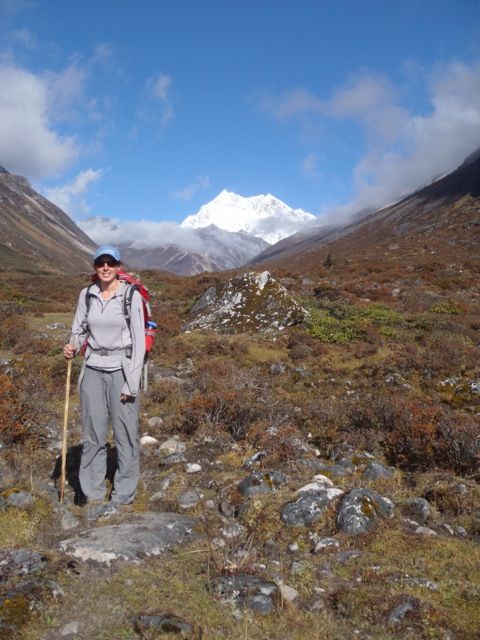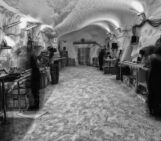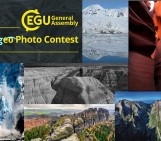Geotalk is a regular feature highlighting early career researchers and their work. Following the EGU General Assembly, we spoke to Stacia Gordon, the winner of the Tectonics and Structural Geology Division Outstanding Young Scientist Award, 2014.
First, could you introduce yourself and tell us a little more about your career path so far?
My name is Stacia Gordon. I am an Assistant Professor at the University of Nevada, Reno (UNR). This fall marks the start of my fifth year at UNR. It is amazing how fast the time has gone by! As an assistant professor, I quickly learned that being successful means being a good juggler and having good time management, as there are so many things that require attendance on a day to day basis…..graduate students, undergraduate students, manuscripts, data reduction, teaching, proposals, service work, etc. Prior to UNR, I had many amazing mentors that helped teach me how to manage all of these tasks that are required of you as a professor. Before I moved to UNR, I spent a semester at the Lamont-Doherty Earth Observatory (LDEO) under the Marie Tharp Fellowship, working with Dr. Peter Kelemen. This was an excellent opportunity to collaborate with a great scientist and meet and interact with many other scientists through the numerous seminars that occur every week at LDEO. LDEO also has the most well-organized intramural sports activities of any Earth Science department. Thus, I thoroughly enjoyed taking a break from science to go play soccer during the week.
I also had an excellent mentor during my postdoctoral research at the University of California-Santa Barbara, working with Dr. Brad Hacker. I think I spent nearly half of the postdoc away from UCSB, traveling for meetings, fieldwork, and lab work, but I learned a large amount of science and various writing tips for submitting a successful proposal from Brad. Brad also introduced me to many new collaborators (most notably Tim Little, Laura Wallace, and Susan Ellis). In addition, spending free time in Santa Barbara is not too shabby, with its lovely combination of ocean and mountains.
My real passion for understanding the mid- to lower-crust began during my dissertation work, while studying under Drs. Donna Whitney and Christian Teyssier at the University of Minnesota. I owe a tremendous amount of gratitude to Donna and Christian and am very happy that I continue to collaborate with them today. In addition, the STAMP (structure, tectonics and metamorphic petrology) group at the U always provided a support network of individuals in which to bounce ideas off of, ask questions, have a beer with, etc. Finally, my dissertation project also introduced me to Bob Miller and Sam Bowring. Both of whom I continue to collaborate with today, and they both had a great influence on my upbringing as a geoscientist. While it was extremely cold living during the winters in Minnesota, the Twin Cities and Pillsbury Hall (where the geology department is housed) were always warm, welcoming places.
During EGU 2014, you received a Division Outstanding Young Scientists Award for your work on integration of microstructural data with geochronology, metamorphic petrology, and geochemistry. Could you tell us a bit more about your research in this area?
I am very interested in understanding the thermal, chemical and rheologic changes that occur during orogenesis, and specifically understanding the interaction and timing among processes, such as metamorphism, deformation, and partial melting. I have been working on these processes in a variety of tectonic environments, from ultrahigh-pressure terranes (Papua New Guinea, the Western Gneiss Region of Norway) to regions where mid- to lower-crustal rocks are exhumed (North Cascades of Washington, eastern Bhutan in Bhutan). I use a combination of field and laboratory work, including various types of geochronology (high-spatial resolution techniques: ion microprobe and laser-ablation inductively coupled plasma mass spectrometry (ICPMS); and high-precision technique: thermal ionization mass spectrometry), ICPMS trace-element analyses, ion microprobe oxygen-isotope analyses, EMPA chemical analyses. These tools allow me to decipher the pressure-temperature-deformation-time path that the rocks underwent within these terranes. Knowing how and when the rocks were deforming and the maximum depths that the rocks reached allows geoscientists to better understand the processes that led to the burial and the exhumation of mid- to lower-crustal rocks. This also contributes to understanding how mountain belts grow and evolve through time, from when the crustal is thickening to when the mountain belt undergoes collapse and extends, falling apart.
What sparked your interest in tectonic processes and what inspired you to use the innovative approach, for which you’ve been recognised, to better understand mountain building and subduction?
This may sound a bit cliché but my interest in tectonic processes began as a child. I was raised in the mid-west of the United States, which has been heavily glaciated and is thus the topography is flat. My family would take vacations to the Western United States where I would see the Rocky Mountains and the Cordillera, both significant orogenic belts. As I child, I wondered why some areas were flat and others mountainous. I decided when I reached the University to take a geology class. After taking Geology 101, an introduction geology class, I specifically became interested in hard-rock geology. I found it fascinating that rocks of the mid- to lower-crust have reached high-enough temperatures to ductilely flow, and I was very interested in understanding how orogenic belts rest upon this very weak, ductilely flowing base. In addition, I was (and still am) fascinated that parts of the crust are taken, via subduction, to mantle depths and are brought back to the surface. My undergraduate research advisor was working on some of these high-pressure rocks exposed in Poland, and I was able to do a small project with him on these rocks. Thus, by the end of my undergraduate education, my interest in hard-rock geology was well developed.
At the General Assembly in 2014 you gave an oral presentation about the findings of your research on the Western Gneiss Region, Norway. Could you tells more about the key findings you presented there?
I have been working in the Western Gneiss Region (WGR) since my postdoc. Brad Hacker introduced me to these incredible rocks, and since this time, Donna Whitney, Christian Teyssier, Haakon Fossen and I have been collaborating, with students, on various parts of the WGR. Within this terrane, it is divided into an ultrahigh-pressure portion (i.e., rocks that were exhumed from mantle depths) and a portion that appears to have also undergone high pressures but that also achieved high-temperature conditions. Within both of these portions of the WGR, there are mafic rocks that are hosted by migmatitic gneisses that underwent partial melting. We have been studying the partial melting history for the WGR because when melt is present, it will be very buoyant. This buoyancy may help exhume rocks from mantle depths. In addition, a small percentage of melt (~7%) will drastically decrease the strength of the rocks; therefore, the melt will play a significant role in how the mountain belt is deforming through time. I have dated numerous of the now crystallized melt bodies and have found that many of the dates that record the timing of melting overlap in time with when the mafic rocks were undergoing metamorphism in the mantle. Thus, this suggests and supports field and experimental evidence from other studies/investigators that partial melting began at mantle depths and may have triggered the switch from the mafic rocks residing in the mantle to being exhumed toward Earth’s surface.
In addition, as mentioned above, we have analysed samples from both portions of the WGR, and we find that the timing of the partial melting is consistent across the entire WGR. This represents a significant portion of the central-western coast of Norway shared the same melting history and thus implies that melting was ubiquitous at the end stages of this mountain building event and likely helped to drive the exhumation of these high-grade rocks back to the surface.
Generally speaking, what are the main challenges when trying to understand the processes that govern burial and exhumation of rocks?
Probably the hardest part about trying to understand these processes is being able to decipher the different parts of the burial and exhumation history. The laboratory tools that I use to understand the pressure-temperature-deformation-time path uses the chemistry of the minerals found in metamorphic rocks. The chemistry of these minerals can preserve a record of multiple thermal events that have occurred over time, and this allows geoscientists to understand both the burial and exhumation history. However, in some cases, the earlier history can become overprinted or erased so that it is difficult to know what happened prior to the exhumation history of the rocks. I would say this is one of the biggest challenges in understanding these challenging rocks.
During field work there are highs and lows, and as your research has taken you to some pretty interesting localities, (Bhutan, Norway, Papua New Guinea) no doubt you’ve had some memorable field work moments whilst at the same time overcoming some tough challenges. Can you tell us more about your field work highs and lows?
The overall high for pretty much all of the places I have worked (besides the rocks) is the scenery: all of these countries are beautiful places. Also, high in the list is the opportunity to meet with local people and see lots of different cultures. Many of these places (e.g., Papua New Guinea and Tajikistan) I would likely have not travelled to as a tourist so I have really enjoyed being able to go there for the geology. In particular, when traveling to countries as a geologist, you likely get off the beaten path very quickly and so I think it is a view of many places that a typical tourist does not see.
There are definitely challenges to working in a variety of these places. In many of the foreign localities, there is a significant communication barrier, where I don’t speak the local language, but we have found some locals who speak English to help with the field work. However, commonly, their English is weak so there is constantly miscommunication about what we want to do, which means that there are constantly evolving plans. This can be very frustrating as typically we want to target very specific rocks that are exposed in very specific geographic locations. It is not until we are in the country that we find out that it is not possible to get to a particular location, which after planning for a trip for multiple months before the field work, can be maddening.
Papua New Guinea (PNG) has definitely been one of the most amazing places to work but also the most frustrating. Most of the people are very kind, but there are also many that assume that as a foreigner from the United States that you have lots of money and are trying to exploit the locals in some way. Thus, we spent many a hours talking to people, explaining what we were doing and trying to get permission to work our way up rivers (where the rocks are exposed). In some cases, the locals would either flat out refuse our request to go up the river or would want a significant amount of money meaning that we would have to turn around and give up on a certain trek. On my two trips to PNG, however, we worked with some fantastic local guides that led us up the rivers. The rocks in the rivers were very slippery, and we would easily fall multiple times throughout the day. The local guides, however, would never slip, carried our heavy back packs, and did it all barefoot! They had the most incredible balance and were extremely savvy with using the local jungle to produce whatever they would need in that moment. For example, at one point, we came to a waterfall that we could not scale. Within 15 minutes, our guides had cut down trees, found vines to use as rope, and built us a ladder to go up and over the waterfall! There were multiple incidents like this that we foreigners would watch in awe!
Field work is definitely one of my favourite parts of the job. I don’t have to sit at a desk all day but instead, get to hike around beautiful mountains. Thus, there definitely many more highs than lows that I have found in all of the places I have worked.
Finally, what does the future hold for you in terms of your research and career plans?
I would like to continue working on some of my current research interests but look forward to developing new skills, investigating new research avenues, mentoring many new graduate students, and collaborating with many new individuals! What I have learned from being a Geoscientist thus far is that there are many questions still to be answered about Earth and that as one researches a topic or chats with a colleague, that new research ideas quickly form.







